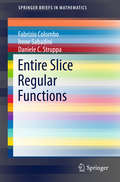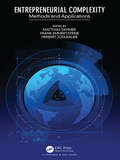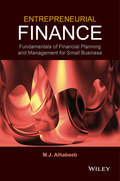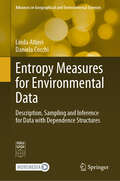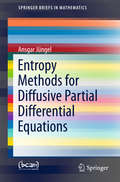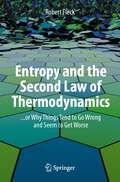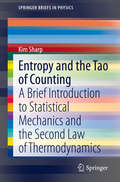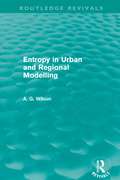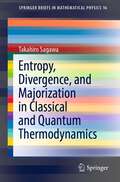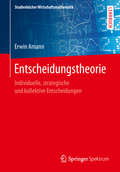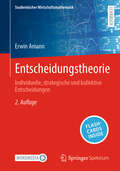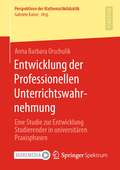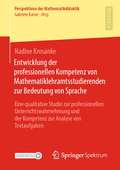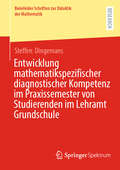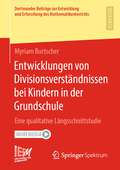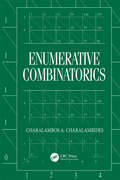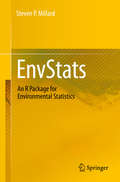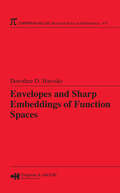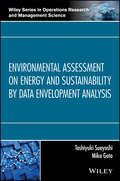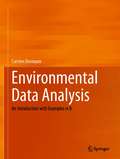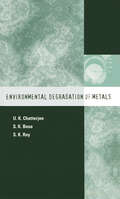- Table View
- List View
Entire Slice Regular Functions
by Daniele C. Struppa Irene Sabadini Fabrizio ColomboThis Briefs volume develops the theory of entire slice regular functions. It is the first self-contained, monographic work on the subject, offering all the necessary background information and detailed studies on several central topics, including estimates on the minimum modulus of regular functions, relations between Taylor coefficients and the growth of entire functions, density of their zeros, and the universality properties. The proofs presented here shed new light on the nature of the quaternionic setting and provide inspiration for further research directions. Also featuring an exhaustive reference list, the book offers a valuable resource for graduate students, postgraduate students and researchers in various areas of mathematical analysis, in particular hypercomplex analysis and approximation theory.
Entrepreneurial Complexity: Methods and Applications
by Matthias Dehmer Frank Emmert-Streib Herbert JodlbauerEntrepreneurial Complexity: Methods and Applications deals with theoretical and practical results of Entrepreneurial Sciences and Management (ESM), emphasising qualitative and quantitative methods. ESM has been a modern and exciting research field in which methods from various disciplines have been applied. However, the existing body of literature lacks the proper use of mathematical and formal models; individuals who perform research in this broad interdisciplinary area have been trained differently. In particular, they are not used to solving business-oriented problems mathematically. This book utilises formal techniques in ESM as an advantage for developing theories and models which are falsifiable. Features Discusses methods for defining and measuring complexity in entrepreneurial sciences Summarises new technologies and innovation-based techniques in entrepreneurial sciences Outlines new formal methods and complexity-models for entrepreneurship To date no book has been dedicated exclusively to use formal models in Entrepreneurial Sciences and Management
Entrepreneurial Finance
by M. J. AlhabeebFeaturing key topics within finance, small business management, and entrepreneurship to develop and maintain prosperous business venturesWith a comprehensive and organized approach to fundamental financial theories, tools, and management techniques, Entrepreneurial Finance: Fundamentals of Financial Planning and Management for Small Business equips readers with the necessary fundamental knowledge and advanced skills to succeed in small firm and business settings. With a unique combination of topics from finance, small business management, and entrepreneurship, the book prepares readers for the challenges of today's economy.Entrepreneurial Finance: Fundamentals of Financial Planning and Management for Small Business begins with key concepts of small business management and entrepreneurship, including management tools and techniques needed to establish, run, and lead business ventures. The book then delves into how small businesses are operated, managed, and controlled. General finance skills and methods are integrated throughout, and the book also features:Numerous practical examples and scenarios that provide a real-world perspective on entrepreneurship and small business managementA brief summary, list of key concepts, and ten discussion questions at the end of each chapter to prepare readers for the challenges of today's economyA practical guide to the complete life of a small business, from establishing a new venture to training and developing young entrepreneurs tasked with maintaining and developing a prosperous economyAn in-depth discussion of the entire process of writing a successful business plan, including the rationale, significance, and requirementsTechniques needed to solidify the free enterprise tradition, develop entrepreneurial strategies, and grow small businessesEntrepreneurial Finance: Fundamentals of Financial Planning and Management for Small Business is an ideal textbook for upper-undergraduate and first-year graduate courses in entrepreneurial finance within business, economics, management science, and public administration departments. The book is also useful for MBA-level courses as well as for business and management PhD majors as a resource in methodology. The book is also an idea reference for entrepreneurs, business managers, market analysts, and decision makers who require information about the theoretical and quantitative aspects of entrepreneurial finance.
Entropy Measures for Environmental Data: Description, Sampling and Inference for Data with Dependence Structures (Advances in Geographical and Environmental Sciences)
by Daniela Cocchi Linda AltieriThis book shows how to successfully adapt entropy measures to the complexity of environmental data. It also provides a unified framework that covers all main entropy and spatial entropy measures in the literature, with suggestions for their potential use in the analysis of environmental data such as biodiversity, land use and other phenomena occurring over space or time, or both. First, recent literature reviews about including spatial information in traditional entropy measures are presented, highlighting the advantages and disadvantages of past approaches and the difference in interpretation of their proposals. A consistent notation applicable to all approaches is introduced, and the authors’ own proposal is presented. Second, the use of entropy in spatial sampling is focused on, and a method with an outstanding performance when data show a negative or complex spatial correlation is proposed. The last part of the book covers estimating entropy and proposes a model-based approach that differs from all existing estimators, working with data presenting any departure from independence: presence of covariates, temporal or spatial correlation, or both. The theoretical parts are supported by environmental examples covering point data about biodiversity and lattice data about land use. Moreover, a practical section is provided for all parts of the book; in particular, the R package SpatEntropy covers not only the authors’ novel proposals, but also all the main entropy and spatial entropy indices available in the literature. R codes are supplemented to reproduce all the examples. This book is a valuable resource for students and researchers in applied sciences where the use of entropy measures is of interest and where data present dependence on space, time or covariates, such as geography, ecology, biology and landscape analysis.
Entropy Methods for Diffusive Partial Differential Equations
by Ansgar JüngelThis book presents a range of entropy methods for diffusive PDEs devised by many researchers in the course of the past few decades, which allow us to understand the qualitative behavior of solutions to diffusive equations (and Markov diffusion processes). Applications include the large-time asymptotics of solutions, the derivation of convex Sobolev inequalities, the existence and uniqueness of weak solutions, and the analysis of discrete and geometric structures of the PDEs. The purpose of the book is to provide readers an introduction to selected entropy methods that can be found in the research literature. In order to highlight the core concepts, the results are not stated in the widest generality and most of the arguments are only formal (in the sense that the functional setting is not specified or sufficient regularity is supposed). The text is also suitable for advanced master and PhD students and could serve as a textbook for special courses and seminars.
Entropy and the Second Law of Thermodynamics: ... or Why Things Tend to Go Wrong and Seem to Get Worse
by Robert FleckThis book is a brief and accessible popular science text intended for a broad audience and of particular interest also to science students and specialists. Using a minimum of mathematics, a number of qualitative and quantitative examples, and clear illustrations, the author explains the science of thermodynamics in its full historical context, focusing on the concepts of energy and its availability and transformation in thermodynamic processes. His ultimate aim is to gain a deep understanding of the second law—the increase of entropy—and its rather disheartening message of a universe descending inexorably into chaos and disorder. It also examines the connection between the second law and why things go wrong in our daily lives. Readers will enhance their science literacy and feel more at home on the science side of author C. P. Snow's celebrated two-culture, science-humanities divide, and hopefully will feel more at home in the universe knowing that the disorder we deal with in our daily lives is not anyone's fault but Nature's.
Entropy and the Tao of Counting: A Brief Introduction to Statistical Mechanics and the Second Law of Thermodynamics (SpringerBriefs in Physics)
by Kim SharpThis book provides a complete and accurate atomic level statistical mechanical explanation of entropy and the second law of thermodynamics. It assumes only a basic knowledge of mechanics and requires no knowledge of calculus. The treatment uses primarily geometric arguments and college level algebra. Quantitative examples are given at each stage to buttress physical understanding. This text is of benefit to undergraduate and graduate students, as well as educators and researchers in the physical sciences (whether or not they have taken a thermodynamics course) who want to understand or teach the atomic/molecular origins of entropy and the second law. It is particularly aimed at those who, due to insufficient mathematical background or because of their area of study, are not going to take a traditional statistical mechanics course.
Entropy in Urban and Regional Modelling (Routledge Revivals #Vol. 1)
by Alan WilsonFirst published in 1970, this groundbreaking investigation into Entropy in Urban and Regional Modelling provides an extensive and detailed insight into the entropy maximising method in the development of a whole class of urban and regional models. The book has its origins in work being carried out by the author in 1966, when he realised that the well-known gravity model could be derived on the basis of an analogy with statistical, rather than Newtonian, mechanics. Subsequent investigation demonstrated that the entropy maximising method stems from an even higher level of generality, and the beginning of the book is devoted to an account of its importance and use as a general modelling tool. This reissue will be welcomed by a range of students and professionals from fields as diverse as urban and regional studies, economics, geography, planning, civil engineering, mathematics and statistics.
Entropy, Divergence, and Majorization in Classical and Quantum Thermodynamics (SpringerBriefs in Mathematical Physics #16)
by Takahiro SagawaRich information-theoretic structure in out-of-equilibrium thermodynamics exists in both the classical and quantum regimes, leading to the fruitful interplay among statistical physics, quantum information theory, and mathematical theories such as matrix analysis and asymptotic probability theory. The main purpose of this book is to clarify how information theory works behind thermodynamics and to shed modern light on it.The book focuses on both purely information-theoretic concepts and their physical implications. From the mathematical point of view, rigorous proofs of fundamental properties of entropies, divergences, and majorization are presented in a self-contained manner. From the physics perspective, modern formulations of thermodynamics are discussed, with a focus on stochastic thermodynamics and resource theory of thermodynamics. In particular, resource theory is a recently developed field as a branch of quantum information theory to quantify “useful resources” and has an intrinsic connection to various fundamental ideas of mathematics and information theory. This book serves as a concise introduction to important ingredients of the information-theoretic formulation of thermodynamics.
Entscheidungstheorie: Individuelle, strategische und kollektive Entscheidungen (Studienbücher Wirtschaftsmathematik)
by Erwin AmannIn diesem Buch werden aufbauend auf die Grundlagen individueller Entscheidungen unter Sicherheit und unter Unsicherheit die wesentlichen Modelle kollektiver Entscheidungen und kompetitiver Märkte sowie strategischer Entscheidungen in der Spieltheorie und Verhandlungstheorie vorgestellt. Entscheidungstheorie ist die Basis aller modernen mikroökonomischen Ansätze. Das Buch soll neben einem guten und möglichst umfassenden Einstieg auch die Option bieten, sich mit klaren mathematischen Begründungen formal vertraut zu machen. Es schafft damit die Basis, sich mit wissenschaftlichen entscheidungstheoretischen Arbeiten kompetent auseinanderzusetzen, aber auch diese Ansätze kritisch zu hinterfragen und eigene Modelle zu entwickeln. Das Lehrbuch für Studierende der Wirtschaftswissenschaften und der Wirtschaftsmathematik schlägt einen Bogen von Anwendungsbeispielen, grundlegenden theoretischen Konzepten bis hin zu den zentralen Beweisen. Zahlreiche unterstützende Grafiken und viele Aufgaben mit Lösungsansätzen erleichtern das Verständnis. In einem Anhang werden wesentliche Definitionen und Verfahren der Optimierung, fundamental für die Entscheidungstheorie, aufgeführt.
Entscheidungstheorie: Individuelle, strategische und kollektive Entscheidungen (Studienbücher Wirtschaftsmathematik)
by Erwin AmannIn diesem Lehrbuch werden aufbauend auf den Grundlagen individueller Entscheidungen unter Sicherheit und unter Unsicherheit die wesentlichen Modelle kollektiver Entscheidungen und kompetitiver Märkte sowie strategischer Entscheidungen in der Spieltheorie und Verhandlungstheorie vorgestellt. Entscheidungstheorie ist die Basis aller modernen mikroökonomischen Ansätze. Das Buch soll neben einem guten und möglichst umfassenden Einstieg auch die Option bieten, sich mit klaren mathematischen Begründungen formal vertraut zu machen. Es schafft damit die Basis, sich mit wissenschaftlichen entscheidungstheoretischen Arbeiten kompetent auseinanderzusetzen, aber auch diese Ansätze kritisch zu hinterfragen und eigene Modelle zu entwickeln. Das Lehrbuch für Studierende der Wirtschaftswissenschaften und der Wirtschaftsmathematik schlägt einen Bogen von Anwendungsbeispielen, grundlegenden theoretischen Konzepten bis hin zu den zentralen Beweisen. Zahlreiche unterstützende Grafiken und viele Aufgaben mit Lösungsansätzen erleichtern das Verständnis. In einem Anhang werden wesentliche Definitionen und Verfahren der Optimierung, fundamental für die Entscheidungstheorie, aufgeführt. Die vorliegende 2. Auflage wurde um eine ausführlichere Einleitung, zusätzliche Inhalte sowie per SN-Flashcards-App digital abrufbare Fragen und Antworten erweitert.
Entwicklung der Professionellen Unterrichtswahrnehmung: Eine Studie zur Entwicklung Studierender in universitären Praxisphasen (Perspektiven der Mathematikdidaktik)
by Anna Barbara OrschulikAnna Barbara Orschulik untersucht in diesem Buch die Entwicklung der professionellen Unterrichtswahrnehmung bei angehenden Lehrkräften im Rahmen von Praxisphasen an der Universität Hamburg, da diese Kompetenz eine hohe Bedeutung für die Qualität von Unterricht und die Leistungen der Lernenden hat. Auf Grundlage einer videobasierten Erhebung wird dabei der Frage nachgegangen, inwiefern sich die professionelle Unterrichtswahrnehmung entwickelt und worauf die festgestellte Entwicklung zurückgeführt werden kann. Die AutorinAnna Barbara Orschulik ist Lehrerin für Geografie und Mathematik und ist seit 5 Jahren ebenfalls in der Lehrerbildung an der Universität Hamburg tätig. Im Rahmen dieser Tätigkeit promovierte sie im Bereich der Mathematikdidaktik bei Prof. Dr. Gabriele Kaiser.
Entwicklung der professionellen Kompetenz von Mathematiklehramtsstudierenden zur Bedeutung von Sprache: Eine qualitative Studie zur professionellen Unterrichtswahrnehmung und der Kompetenz zur Analyse von Textaufgaben (Perspektiven der Mathematikdidaktik)
by Nadine KrosankeDie qualitative Studie von Nadine Krosanke versteht sich als Forschungsbeitrag zur Untersuchung von Professionalisierungsprozessen von Lehrkräften im Hinblick auf Kompetenzen im Bereich Sprache im Mathematikunterricht. Dabei wird die Frage untersucht, inwiefern sich nach der Teilnahme an einem neu konzipierten Seminar an der Universität Hamburg bei den teilnehmenden Mathematiklehramtsstudierenden Zuwächse in der Kompetenz zur Analyse von potenziellen sprachlichen Hürden in Textaufgaben und hinsichtlich der professionellen Unterrichtswahrnehmung identifizieren lassen, insbesondere hinsichtlich der Bedeutung von Sprache beim fachlichen Lernen und Lehren.
Entwicklung mathematikspezifischer diagnostischer Kompetenz im Praxissemester von Studierenden im Lehramt Grundschule (Bielefelder Schriften zur Didaktik der Mathematik #17)
by Steffen DingemansDie Qualität eines Unterrichts, der sich an den individuellen Voraussetzungen der Schulkinder orientiert, hängt maßgeblich mit der diagnostischen Kompetenz der Lehrkraft zusammen. Folglich ist die Entwicklung dieser eine grundlegende Aufgabe aller drei Phasen der Lehrkräftebildung. In der vorliegenden Studie wird das Praxissemester als struktureller Bestandteil der ersten Phase der Lehramtsausbildung fokussiert und die Wirkung auf die Entwicklung mathematikspezifischer diagnostischer Kompetenz untersucht. Den Kern der als mixed-method angelegten längsschnittlichen Evaluation stellen vier Videovignetten dar, zu denen die Studierenden aus dem Grundschullehramt in einer Online-Umfrage mit offenen Antwortformaten aufgefordert wurden, die Lösungswege von Kindern zur Addition und Subtraktion fachlich angemessen zu analysieren. Die Ergebnisse bestätigen einerseits die geringe Effektivität vor allem der schulischen Praxisphase. Anderseits werden auf Basis der vorliegenden Daten relevante Bedingungsfaktoren herausgearbeitet und Verbesserungsmöglichkeiten für die universitäre und schulische Phase des Praxissemesters diskutiert.
Entwicklungen von Divisionsverständnissen bei Kindern in der Grundschule: Eine qualitative Längsschnittstudie (Dortmunder Beiträge zur Entwicklung und Erforschung des Mathematikunterrichts #50)
by Myriam BurtscherEin tragfähiges Verständnis der Division ist für die Schülerinnen und Schüler weit über die Grundschule hinaus von großer Bedeutung. Wie eine Bestandaufnahme der einschlägigen empirischen Forschung auf internationaler Ebene deutlich macht, erweist sich unter den vier Grundrechenarten die Division für Lernende als die größte Herausforderung. Die vorliegende Forschungsarbeit untersucht Entwicklungsverläufe zum Verständnis der Division bei elf Grundschulkindern aus zwei verschiedenen Schulklassen über drei Schuljahre hinweg. Die Ergebnisse der Interviews zeigen, dass bei einigen der vier untersuchten Darstellungswechsel für die Kinder eine Reihe von Problemen und Schwierigkeiten auftraten, die insbesondere mit der Zwiegestalt der Division in Verbindung stehen.
Enumerative Combinatorics
by Richard P. StanleyThis second volume of a two-volume basic introduction to enumerative combinatorics covers the composition of generating functions, trees, algebraic generating functions, D-finite generating functions, noncommutative generating functions, and symmetric functions. The chapter on symmetric functions provides the only available treatment of this subject suitable for an introductory graduate course on combinatorics, and includes the important Robinson-Schensted-Knuth algorithm. Also covered are connections between symmetric functions and representation theory. An appendix by Sergey Fomin covers some deeper aspects of symmetric function theory, including jeu de taquin and the Littlewood-Richardson rule. As in Volume 1, the exercises play a vital role in developing the material. There are over 250 exercises, all with solutions or references to solutions, many of which concern previously unpublished results. Graduate students and research mathematicians who wish to apply combinatorics to their work will find this an authoritative reference.
Enumerative Combinatorics (Discrete Mathematics and Its Applications)
by Charalambos A. CharalambidesEnumerative Combinatorics presents elaborate and systematic coverage of the theory of enumeration. The first seven chapters provide the necessary background, including basic counting principles and techniques, elementary enumerative topics, and an extended presentation of generating functions and recurrence relations. The remaining seven chapters focus on more advanced topics, including, Stirling numbers, partitions of integers, partition polynomials, Eulerian numbers and Polya's counting theorem.Extensively classroom tested, this text was designed for introductory- and intermediate-level courses in enumerative combinatorics, but the far-reaching applications of the subject also make the book useful to those in operational research, the physical and social science, and anyone who uses combinatorial methods. Remarks, discussions, tables, and numerous examples support the text, and a wealth of exercises-with hints and answers provided in an appendix--further illustrate the subject's concepts, theorems, and applications.
Enumerative Combinatorics, Volume 1
by Richard P. StanleyRichard Stanley's two-volume basic introduction to enumerative combinatorics has become the standard guide to the topic for students and experts alike. This thoroughly revised second edition of Volume 1 includes ten new sections and more than 300 new exercises, most with solutions, reflecting numerous new developments since the publication of the first edition in 1986. The material in Volume 1 was chosen to cover those parts of enumerative combinatorics of greatest applicability and with the most important connections with other areas of mathematics. The four chapters are devoted to an introduction to enumeration (suitable for advanced undergraduates), sieve methods, partially ordered sets, and rational generating functions. Much of the material is related to generating functions, a fundamental tool in enumerative combinatorics. In this new edition, the author brings the coverage up to date and includes a wide variety of additional applications and examples, as well as updated and expanded chapter bibliographies. Many of the less difficult new exercises have no solutions so that they can more easily be assigned to students. The material on P-partitions has been rearranged and generalized; the treatment of permutation statistics has been greatly enlarged; and there are also new sections on q-analogues of permutations, hyperplane arrangements, the cd-index, promotion and evacuation, and differential posets.
EnvStats
by Steven P. MillardThis book describes EnvStats, a new comprehensive R package for environmental statistics and the successor to the S-PLUS module EnvironmentalStats for S-PLUS (first released in 1997). EnvStats and R provide an open-source set of powerful functions for performing graphical and statistical analyses of environmental data, bringing major environmental statistical methods found in the literature and regulatory guidance documents into one statistical package, along with an extensive hypertext help system that explains what these methods do, how to use these methods, and where to find them in the environmental statistics literature. EnvStats also includes numerous built-in data sets from regulatory guidance documents and the environmental statistics literature. This book shows how to use EnvStats and R to easily: * graphically display environmental data * plot probability distributions * estimate distribution parameters and construct confidence intervals on the original scale for commonly used distributions such as the lognormal and gamma, as well as do this nonparametrically * estimate and construct confidence intervals for distribution percentiles or do this nonparametrically (e. g. , to compare to an environmental protection standard) * perform and plot the results of goodness-of-fit tests * compute optimal Box-Cox data transformations * compute prediction limits and simultaneous prediction limits (e. g. , to assess compliance at multiple sites for multiple constituents) * perform nonparametric estimation and test for seasonal trend (even in the presence of correlated observations) * perform power and sample size computations and create companion plots for sampling designs based on confidence intervals, hypothesis tests, prediction intervals, and tolerance intervals * deal with non-detect (censored) data * perform Monte Carlo simulation and probabilistic risk assessment * reproduce specific examples in EPA guidance documents EnvStats combined with other R packages (e. g. , for spatial analysis) provides the environmental scientist, statistician, researcher, and technician with tools to "get the job done!"
Envelopes and Sharp Embeddings of Function Spaces (Chapman & Hall/CRC Research Notes in Mathematics Series)
by Dorothee D. HaroskeUntil now, no book has systematically presented the recently developed concept of envelopes in function spaces. Envelopes are relatively simple tools for the study of classical and more complicated spaces, such as Besov and Triebel-Lizorkin types, in limiting situations. This theory originates from the classical result of the Sobolev embedding theo
Environmental & Social Justice Challenges Near America’s Most Popular Museums, Parks, Zoos & Other Heritage Attractions
by Michael GreenbergThis book examines environmental and social justice challenges near America's most popular heritage attractions. These include over 100 places that host national parks (e.g., Glacier, Yellowstone), zoos (e.g., Bronx, Henry Doorly), urban parks (e.g., Central Park, Fairmount), grand concourses (e.g., 5th Avenue, Massachusetts Avenue), and multiple museums and galleries (e.g., National Gallery, Getty). The book includes measurements of demographics, air quality/distance from hazards, health outcomes, and urban assets in the areas immediately surrounding these heritage sites and compares them with adjacent areas and their host cities or states. It considers the history of justice-related-issues near the sites and evaluates what owners, managers and communities are doing to address gentrification, displacement, the legacy of redlining and other challenges, such as the animal rights movement, climate change/sustainability, and tight budgets. The book examines what some host cities are doing about affordable housing and what some heritage sites have done in establishing constructive relationships with surrounding communities. The book should have two primary audiences. One is the strong and growing social and environmental justice community that has increasingly been scrutinizing parks and other icons for evidence of injustice. This book will interest them, even though all the results do not necessarily support their positions. The second audience is businesses, not-for-profits, and government agencies who manage parks, zoos, museums, and other attractions and need to understand what is happening near their sites and what they can do to be better neighbours.
Environmental Assessment on Energy and Sustainability by Data Envelopment Analysis
by Toshiyuki Sueyoshi Mika GotoIntroduces a bold, new model for energy industry pollution prevention and sustainable growth Balancing industrial pollution prevention with economic growth is one of the knottiest problems faced by industry today. This book introduces a novel approach to using data envelopment analysis (DEA) as a powerful tool for achieving that balance in the energy industries—the world’s largest producers of greenhouse gases. It describes a rigorous framework that integrates elements of the social sciences, corporate strategy, regional economics, energy economics, and environmental policy, and delivers a methodology and a set of strategies for promoting green innovation while solving key managerial challenges to greenhouse gas reduction and business growth. In writing this book the authors have drawn upon their pioneering work and considerable experience in the field to develop an unconventional, holistic approach to using DEA to assess key aspects of sustainability development. The book is divided into two sections, the first of which lays out a conventional framework of DEA as the basis for new research directions. In the second section, the authors delve into conceptual and methodological extensions of conventional DEA for solving problems of environmental assessment in all contemporary energy industry sectors. Introduces a powerful new approach to using DEA to achieve pollution prevention, sustainability, and business growth Covers the fundamentals of DEA, including theory, statistical models, and practical issues of conventional applications of DEA Explores new statistical modeling strategies and explores their economic and business implications Examines applications of DEA to environmental analysis across the complete range of energy industries, including coal, petroleum, shale gas, nuclear energy, renewables, and more Summarizes important studies and nearly 800 peer reviewed articles on energy, the environment, and sustainability Environmental Assessment on Energy and Sustainability by Data Envelopment Analysis is must-reading for researchers, academics, graduate students, and practitioners in the energy industries, as well as government officials and policymakers tasked with regulating the environmental impacts of industrial pollution.
Environmental Chemometrics: Principles and Modern Applications
by Grady HanrahanMultivariate, heterogeneous data has been traditionally analyzed using the "one at a time" variable approach, often missing the main objective of discovering the relationships among multiple variables and samples. Enter chemometrics, with its powerful tools for design, analysis, and data interpretation of complex environmental systems. Delineating
Environmental Data Analysis: An Introduction with Examples in R
by Carsten DormannEnvironmental Data Analysis is an introductory statistics textbook for environmental science. It covers descriptive, inferential and predictive statistics, centred on the Generalized Linear Model. The key idea behind this book is to approach statistical analyses from the perspective of maximum likelihood, essentially treating most analyses as (multiple) regression problems. The reader will be introduced to statistical distributions early on, and will learn to deploy models suitable for the data at hand, which in environmental science are often not normally distributed. To make the initially steep learning curve more manageable, each statistical chapter is followed by a walk-through in a corresponding R-based how-to chapter, which reviews the theory and applies it to environmental data. In this way, a coherent and expandable foundation in parametric statistics is laid, which can be expanded in advanced courses.The content has been “field-tested” in several years of courses on statistics for Environmental Science, Geography and Forestry taught at the University of Freiburg.
Environmental Degradation of Metals: Corrosion Technology Series/14 (Corrosion Technology)
by U.K. Chatterjee S.K. Bose S.K. RoyThis highly practical reference presents for the first time in a single volume all types of environmental degradation a metallic compound may undergo during its processing, storage, and service. Clarifying general and localized corrosion effects, Environmental Degradation of Metals describes the effects of atmospheric exposure, high-temperature gas
